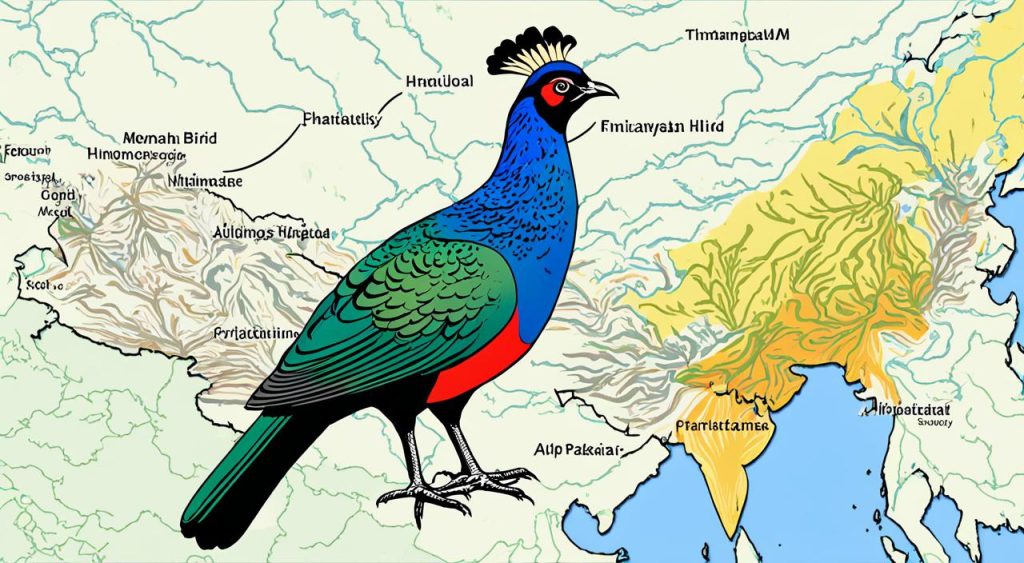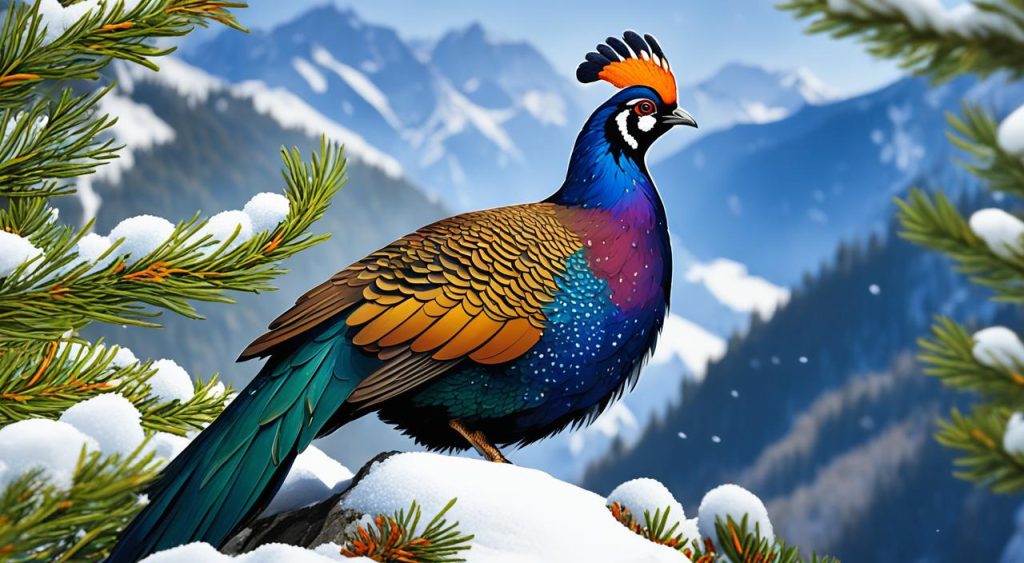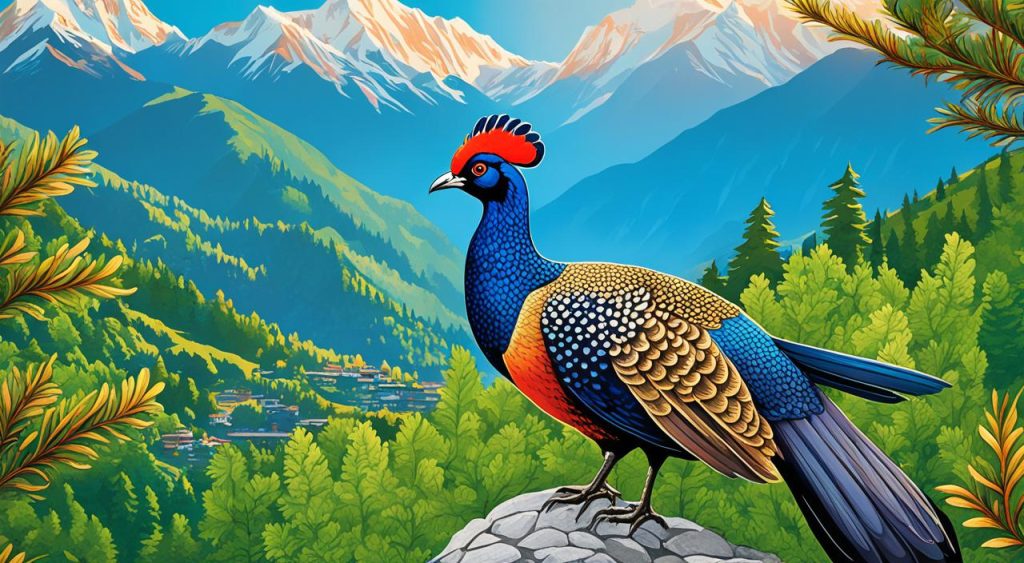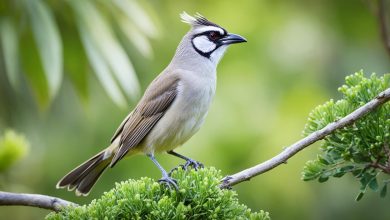Deep in the Himalayas, the Himalayan Monal (Lophophorus impejanus) stands out as a breathtaking bird. Known as the “danphe” or “danfe,” it’s the national bird of Nepal. It symbolizes the country’s natural beauty and culture.
This bird is known for its bright, shiny feathers and noble look. It’s a big bird in the Phasianidae family, sometimes weighing up to 2,380 grams. Seeing it in the wild is an unforgettable experience.
The Himalayan Monal lives in Afghanistan, Pakistan, India, Nepal, southern Tibet, and Bhutan. It calls the upper temperate forests and sub-alpine grasslands of the Himalayas home. It lives between 2,100 to 4,500 meters above sea level. Thanks to its ability to adapt, it’s a beloved part of the region’s wildlife.
The Magnificent Himalayan Monal
The Himalayan Monal, also known as the Danphe, is Nepal’s national bird. It’s a stunning member of the pheasant family. This bird is a true wonder of nature.
Physical Characteristics of the National Bird of Nepal
This bird can grow up to 74 centimeters long, including its long tail. Its vibrant, iridescent feathers stand out. The male Himalayan Monal catches the eye with its metallic green head and coppery feathers.
It also has blue wings and a long, green tail with unique markings. Females are less colorful but still beautiful, with browns, grays, and blacks.
Vibrant Plumage and Distinctive Features
Both males and females have a special crest on their heads. They can raise and lower it, often during courtship displays. This shows sexual dimorphism, with males being more colorful and larger.
The Himalayan Monal’s Lophophorus impejanus is known for its iridescent plumage and crest. It’s a standout in ornithology. This bird shows the beauty of the Himalayas.
“The vibrant, iridescent feathers of the Himalayan Monal symbolize the beauty and diversity of Nepal’s landscapes.”
Habitat and Distribution
Exploring the Himalayan Regions
The Himalayan Monal lives in the stunning Himalayan regions. It spans from Afghanistan and Pakistan to Nepal, southern Tibet, and Bhutan. This bird loves the high places, living between 2,100 to 4,500 meters (6,900–14,800 feet) above sea level.
It calls the alpine and sub-alpine zones home. You can find it in rhododendron forests, grassy slopes, and rocky areas. Its ability to live in the tough Himalayan mountains shows how strong and skilled it is.
In Pakistan and India, the Himalayan foothills are perfect for the Himalayan Monal. Birdwatchers and nature lovers often see it there. It also lives in parts of Nepal, Bhutan, and southern Tibet.

Studies show that the Himalayan Monal likes living on steep slopes. But it stays away from Reserve Forests. There are about 5.63 birds per square kilometer, with some places having more.
This bird is amazing at adapting to the tough mountain life. Seeing it in the Himalayas is an experience birdwatchers and nature lovers will always remember.
Himalayan Monal
The Himalayan Monal (Lophophorus impejanus) is a stunning pheasant from the Himalayas in South Asia. It belongs to the Phasianidae family, which includes pheasants, partridges, and grouse. This bird is famous for its bright, shiny feathers and unique look. It stands out in the diverse bird life of the Himalayas.
This bird is classified under Class Aves, Order Galliformes, Family Phasianidae, Genus Lophophorus, and species Lophophorus impejanus. It lives in Afghanistan, Pakistan, India, Nepal, southern Tibet, and Bhutan. Himalayan Monals often hang out in pairs or small groups. They gather in large groups during winter.
They eat a wide variety of foods like insects, seeds, tubers, roots, and berries. The breeding season is from April to August. Females lay 3 to 5 eggs after 27 days of incubation. The male takes care of the nest and the chicks early on. They start to breed at about 2 years old.
| Characteristic | Description |
|---|---|
| Plumage | Male Himalayan monals have bright and colorful feathers of blue, green, purple, and red, while females and young birds have an overall brown appearance. Both sexes have distinctive blue circles of skin around their eyes. |
| Underside | The male Himalayan monals have a white patch of feathers underneath the base of their tail, with the rest of their underside being black. Females have white throats. |
| Conservation Status | The Himalayan Monal is currently classified as Least Concern (LC) on the IUCN Red List, indicating a decreasing trend in population numbers due to threats such as poaching, habitat destruction, and hunting for decorative feathers. |
Despite challenges, the Himalayan Monal is an important and culturally significant bird. It is the national bird of Nepal and the state bird of Uttarakhand, India. Its unique look and characteristics fascinate birdwatchers and nature lovers. It’s a gem of the Himalayan ecosystem.
“The Himalayan Monal, with its vibrant plumage and distinctive features, is a true marvel of nature and a testament to the ecological richness of the Himalayan regions.”
Behavior and Ecology
The Himalayan Monal is Nepal’s national bird, known for its varied foraging and beautiful courtship. These birds are key to the Himalayan ecosystem. They help with nutrient cycling and controlling insects.
Foraging Habits and Diet
The Himalayan Monal eats a wide variety of plants and insects. Its strong bill lets it dig up food from the ground. This helps with nutrient cycling and keeps insect populations in check.
Courtship Displays
From April to June, male Himalayan Monals show off to find mates. They puff out their bright feathers, stand tall, and make loud calls. This helps them show off and win over females.
| Foraging Habits | Courtship Displays |
|---|---|
| Diverse diet of plant matter, insects, and grubs Robust bill allows for effective digging of buried food items Plays a crucial role in nutrient cycling and insect control | Breeding season from April to June Male Himalayan Monals fluff up their plumage and erect crest feathers Emit melodious calls to establish dominance and attract mates |

The Himalayan Monal’s foraging and courtship are vital to the ecosystem. They show how nature’s balance works in these stunning mountains.
Breeding and Nesting
The Himalayan Monal, Nepal’s national bird, is known for its beautiful breeding and nesting habits. These birds breed from April to August, usually in pairs. The female builds a simple nest on the ground, hidden in thick plants. She lays 3 to 6 eggs in it.
The eggs take about 3 weeks to hatch. When they hatch, the chicks are covered in down and can find food on their own quickly. The male doesn’t help with raising the young but stays close to protect them from danger.
| Breeding Characteristic | Description |
|---|---|
| Breeding Season | April to August |
| Pair Formation | Monogamous |
| Nest Location | Shallow ground nests, often concealed in dense vegetation |
| Clutch Size | 3 to 6 eggs |
| Incubation Period | Approximately 3 weeks |
| Chick Characteristics | Precocial, with downy feathers and ability to forage independently |
| Parental Care | Female incubates and raises chicks, while male may defend them |
The Himalayan Monal’s breeding and nesting show how well it has adapted to the tough high places of the Himalayas. Learning about these habits helps us value this bird more and support its conservation.
Role in the Ecosystem
The Himalayan Monal is a vibrant bird that plays a key role in the Himalayan ecosystem. It helps keep the ecosystem balanced by spreading seeds. This helps the diverse plants in the mountains grow and thrive.
Seed Dispersal and Insect Control
This bird eats different plant and animal parts, spreading seeds as it goes. This helps new plants grow. It also eats many insects, keeping their numbers in check. This balance is important for the ecosystem’s health.
The Himalayan Monal is key to the ecosystem’s health. It helps with seed dispersal and insect control. This supports the mountain biodiversity that makes the Himalayas unique.
“The Himalayan Monal is a true ambassador of the region’s natural wonders, showcasing the intricate web of life that sustains the himalayan ecosystem.”

Studies show how important the Himalayan Monal is for seed dispersal and insect control. Surveys in the Garhwal Himalayas of India found the bird’s big impact on local plants and animals.
As the national bird of Nepal, the Himalayan Monal is a symbol of pride. It’s also vital to the region’s mountain biodiversity. Protecting its home and keeping the himalayan ecosystem healthy is crucial for this special bird.
Conservation Efforts
The Himalayan Monal is a beautiful bird that faces many threats. It’s listed as “Least Concern” globally but “Near Threatened” in Nepal. This shows we need to act to save it.
Threats and Protection Measures
Humans are the main threat, cutting down forests and breaking up its home. Poachers also want its feathers. We must protect its home and stop these threats to save the Himalayan Monal.
We need to stop poaching with more patrols and enforcing laws. Also, restoring and protecting its home is key. This will help the Himalayan Monal survive.
The Himalayan Monal is Nepal’s national bird, known as “danphe” or “danfe.” It’s important to many people. Local communities are helping to protect it, showing strong community support for conservation.
Teaching the next generation about the Himalayan Monal is vital. We need to teach them why it’s important to save this bird and its home. This will help them keep up the conservation work.
We can save the Himalayan Monal with a plan that includes protecting its home, stopping poaching, community help, and teaching the public. By saving this bird, we also protect the Himalayan ecosystem’s rich variety of life.
Cultural Significance
The Himalayan Monal, known as the “Danphe” in Nepal, is very important in Nepali culture and stories. This beautiful pheasant has feathers of blue, green, red, and gold. It symbolizes Nepal’s rich natural beauty.
In Nepali stories, the Himalayan Monal is seen as a god’s messenger. It is admired for its grace, beauty, and link to the divine.
Nepal has named the Himalayan Monal its national bird. This shows how much it means to the culture. The bird is in traditional songs, dances, and rituals. It is a symbol of Nepal’s rich culture.
The Himalayan Monal, or Danphe, makes Nepalis proud. It is known for its bright colors and symbolizes Nepal’s cultural heritage.
Nepali Folklore and Traditions
The Himalayan Monal, or Danphe, is a big part of Nepali stories and traditions. Legends say it brings messages and blessings from the heavens. Some stories say it has magical powers, making it very respected in Nepal.
- The Danphe is often seen in Nepali art, on textiles, pottery, and more.
- Folk songs and dances about the Danphe are performed at festivals and events.
- Its feathers are used in ceremonial headdresses and decorations, showing its importance.
The Himalayan Monal is a big part of Nepali stories and traditions. It shows the strong bond between the people and the Himalayas. The Danphe is a symbol of Nepal’s rich culture, touching the hearts of Nepalis and visitors.

Himalayan Biodiversity
The Himalayan Monal is just one of the many species that live in the Himalayas. This region is known for its himalayan biodiversity. It’s home to everything from snow leopards to rhododendron forests.
The Himalayas have an amazing 979 bird species and 300 mammal species. You can find snow leopards, red pandas, and the Himalayan Monal here. There are also approximately 10,000 vascular plant species, with 3,160 rare, endemic, and sensitive plant varieties. This shows how rich the mountain ecosystems are in life.
Protecting the Himalayan Monal and its home helps keep the himalayan ecosystem balanced. Conservation efforts and ecotourism potential are key to saving the Monal and the himalayan biodiversity.
“The Himalayas are one of 36 biodiversity hotspots with around 3,160 rare, endemic, and sensitive plant varieties.”
The Himalayas are vital for Asia’s rivers and are known as the world’s water tower. They also store a lot of 62% of total forest carbon, making them important carbon sinks. But, the region is warming faster than the rest of the world, which threatens the mountain ecosystems.
We can protect the Himalayan Monal and the himalayan biodiversity by using sustainable practices and ecotourism potential. Together, we can keep these natural wonders safe for the future.
Birdwatching Hotspots
The Himalayan regions of Nepal, India, and Bhutan are famous for himalayan monal birdwatching, himalayan birdwatching, nepal birdwatching, india birdwatching, and bhutan birdwatching. These places are full of mountain avifauna. They let birdwatchers see the amazing Himalayan Monal and many other beautiful birds.
The foothills and high places in these countries are great for finding the Himalayan Monal. Many birdwatchers go to these himalayan monal birdwatching spots. They want to see this beautiful bird of Nepal in the wild and enjoy the Himalayas’ rich bird life.
The 2018 Zoological Survey of India found over 900 bird species in the Himalayas. 80% of India’s birds live here. The area has untouched forests, high-altitude wetlands, rivers, and farmland. This makes it a place full of different birds.
| Birdwatching Destination | Notable Bird Species |
|---|---|
| Deoriatal – Chandrashila Trek | 70-100 bird species on any given day |
| Singalila National Park | Close to 300 bird species recorded |
| Dayara Bugyal Trek | Over 40 bird species, including Himalayan Monal |
| Brahmatal Trek | Sightings of the Himalayan Griffon or Vulture |
| Chirbatiya Trek | Ideal for newcomers to birdwatching |
These himalayan birdwatching spots are amazing. Places like Chitwan National Park, Koshi Tappu Wildlife Reserve, Langtang National Park, Pulchoki Hill, Bardia National Park, and Shivapuri Nagarjun National Park are also great. They let birdwatchers see many different Himalayan birds, including rare ones.
“The Himalayas are a true treasure trove for birdwatchers, offering unparalleled opportunities to witness the region’s magnificent and diverse avifauna.”
Eco-tourism Opportunities
The Himalayan Monal and the region’s rich biodiversity offer special ecotourism chances. These can help conservation and sustainable growth in the Himalayas. Traveling responsibly can make money and spread awareness, helping people value the area’s natural beauty.
Sustainable Tourism in the Himalayas
Sustainable tourism, like birdwatching tours and educational programs, lets visitors enjoy the Himalayan Monal’s home. It also helps protect this amazing bird and its mountain home. In Latpanchar village in India, over 15,000 locals support ecotourism through various activities.
In India, thousands of birdwatchers join high-end birding tours in the Himalayas. In Baihualing village, China, bird photography tourism brings in USD 3,000 to 5,000 a year per household. Nearby Hanlong village, 86% of families earn from this green tourism.
Local communities gain from ecotourism through new skills and jobs. This helps with conservation and biodiversity. For example, Himalayan Ecotourism supports education, empowers women, and helps with reforestation.
Travelers can help by choosing shared transport, driving carefully, and buying local products. This helps protect the Himalayan Monal and its home.
Ecotourism in the Himalayas is key to conservation and sustainable growth. It lets visitors connect with nature and support local communities. By choosing sustainable options, we can help the Himalayan Monal and its ecosystem thrive for the future.
Preserving the Himalayan Ecosystem
The survival of the Himalayan Monal is tied to the health of the Himalayan ecosystem. This bird is a vital part of the mountain’s life. Protecting it and its home is key to keeping the region’s biodiversity safe.
The Himalayas are home to 10,000 plant species, 979 birds, and 300 mammals. This makes them one of the world’s most biodiverse places. It’s a treasure of nature that we must protect.
Human actions like habitat destruction and climate change threaten the Himalayas. We need a strong plan for sustainable development to save this region. Climate change is warming the Himalayas faster than anywhere else, making action urgent.
By saving the Himalayan Monal and its ecosystem, we help future generations. This will keep the natural beauty of the Himalayas alive for them.
The Convention on Biological Diversity sees saving the Himalayas as crucial. These mountains support communities and help people’s lives. World leaders will meet in China this October to discuss how to protect these ecosystems.
The UN Decade on Restoration 2021-2030 shows the world’s commitment to saving nature. The Himalayas will be a key focus of this effort. This decade aims to restore and protect nature, with the Himalayas leading the way.
FAQ
What is the Himalayan Monal?
The Himalayan Monal is a beautiful pheasant from South Asia’s Himalayas. It’s Nepal’s national bird, known as the “danphe” or “danfe”. It’s famous for its bright, shiny feathers and regal look.
What are the physical characteristics of the Himalayan Monal?
This bird is quite big, reaching up to 74 centimeters long, including its long tail. Its bright, shiny feathers stand out. The male is very colorful, with a green head, copper feathers on the back, blue wings, and a long, shiny green tail. Females are less colorful but still look great, with browns, grays, and blacks. Both have a special crest on their heads.
Where is the Himalayan Monal found?
You can find the Himalayan Monal in the Himalayas, from Afghanistan and Pakistan to Nepal, Tibet, and Bhutan. It lives in high places, from 2,100 to 4,500 meters up. It likes alpine and sub-alpine zones, rhododendron forests, grassy slopes, and rocky areas.
What is the diet of the Himalayan Monal?
This bird eats a lot of plants, like tubers, roots, seeds, berries, and mosses. It also eats insects and grubs. Its strong bill helps it dig up food, which is important for the ecosystem.
How does the Himalayan Monal breed and nest?
The breeding season is from April to June. Birds nest high up in their home. Females make shallow nests on the ground, hidden in thick plants. They lay eggs that hatch after about three weeks. The chicks are born with down feathers and can find food on their own soon after.
What is the conservation status of the Himalayan Monal?
Worldwide, the Himalayan Monal is not considered endangered. But in Nepal, it’s considered “Near Threatened”. This means it needs protection from threats like deforestation and feather poaching.
What is the cultural significance of the Himalayan Monal in Nepal?
In Nepal, the Himalayan Monal is very important. It’s called the “Danphe” and is seen as a symbol of Nepal’s beauty. In stories and myths, it’s a messenger of the gods, known for its beauty and connection to the divine.
How can eco-tourism contribute to the conservation of the Himalayan Monal?
Eco-tourism can help protect the Himalayan Monal and its home. It can make money and teach people about the importance of nature. By doing things like birdwatching tours and educational programs, visitors can learn about the Monal while helping to save it and its home.




